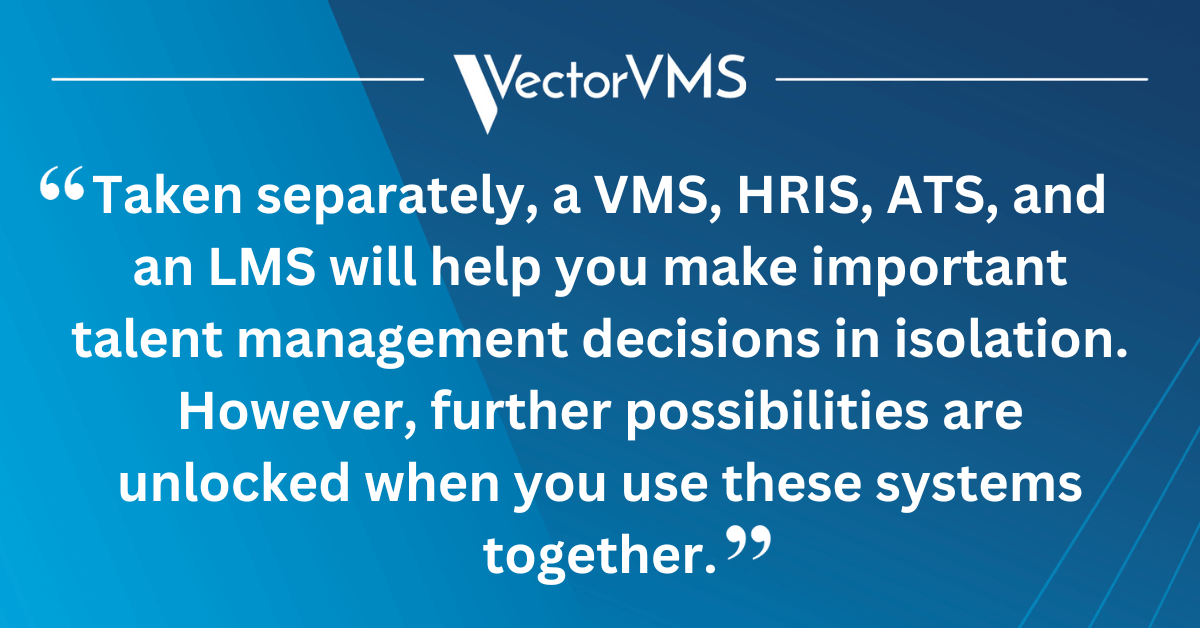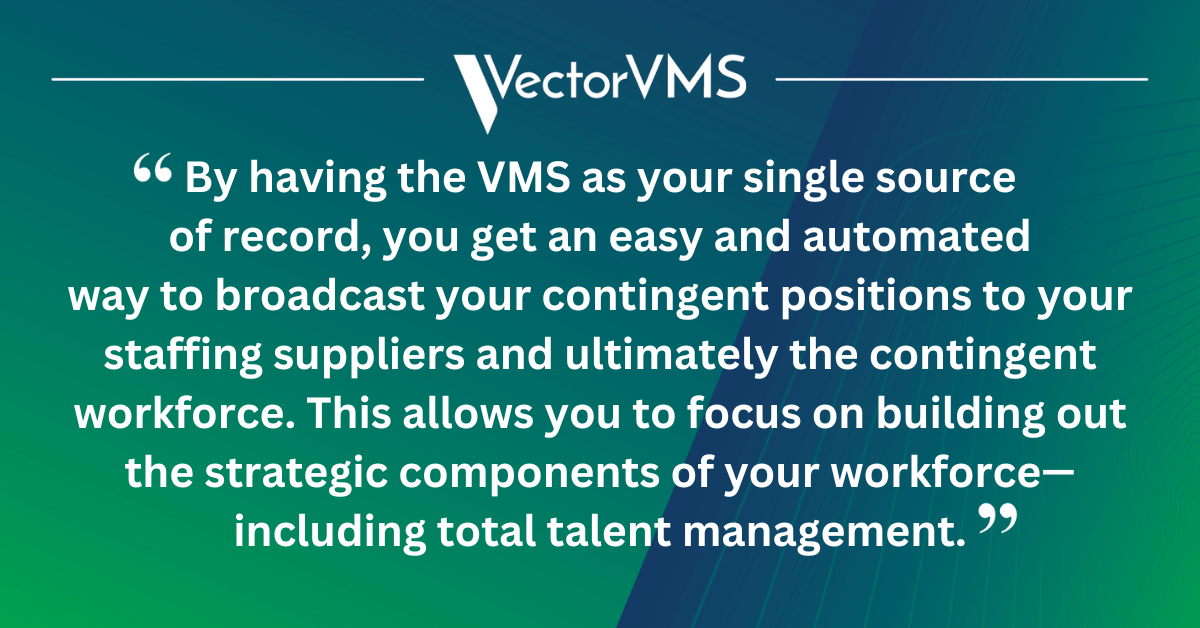Technology plays a significant role in talent acquisition today: some organizations can run their programs efficiently with only a vendor management system (VMS), while others might need extra tools in place for optimal management. The key is to understand which technologies your total talent management program requires and why. You must also consider how all these solutions will interact with each other to provide additional value.
Here are four of the most commonly used technologies in a total talent management strategy:
1) Vendor Management System (VMS)
A vendor management system (VMS) is a tool for managing your contingent labor. It streamlines the process of sourcing, engaging, and administrating contingent workers from various staffing agencies or other third-party providers.
A VMS can include job requisition management, candidate sourcing and selection, onboarding, time and expense management, and reporting and analytics. It provides visibility into the entire contingent workforce, allowing companies to better manage their extended workforce and make data-driven decisions. You can set it up according to your requirements, it could act solely as a requisition system, or it can handle the entire contingent workforce cycle.
Why Would You Need a VMS?
While you can try to manage your contingent workforce through spreadsheets and emails, you’ll find over time this just isn’t a sustainable solution. To find the best talent in a reasonable amount of time, it’s best to implement a VMS to handle the tactical components of contract labor like sourcing, onboarding, and time management.
By having the VMS as your single source of record, you get an easy and automated way to broadcast your contingent positions to your staffing suppliers and ultimately the contingent workforce. This allows you to focus on building out the strategic components of your workforce—including total talent management.
LEARN MORE | ‘4 Vendor Management Improvements You Might Be Missing’

2) Human Resource Information System (HRIS)
A Human Resource Information System (HRIS) is a software system that enables human resource management tasks to be automated and streamlined. It’s designed to assist HR professionals in managing employee information, tracking employee records, and accessing important data such as employee attendance records, job histories, and performance evaluations.
The HRIS system helps to reduce the time and effort required to perform routine HR tasks, such as updating employee records, tracking employee training, and managing employee benefits.
Why Would You Need an HRIS?
An HRIS is one of the most commonly used tools in any HR department. It can be integrated with other systems such as an ATS or VMS to provide a comprehensive HR management solution.
Overall, the implementation of an HRIS system can greatly improve the efficiency and effectiveness of HR management. It can reduce the workload of HR professionals, increase employee engagement, and improve compliance with legal requirements.
3) Applicant Tracking System (ATS)
An applicant tracking system (ATS) is software used to manage and automate an organization’s hiring process. It serves as a repository for all applicant information, allowing hiring managers to easily view and track candidate progress through the entire pipeline. An ATS can create efficiencies in the hiring process via use of data analysis tools and customer relationship management features. It may also have a tracking component that can be integrated with other hiring technologies.
When an ATS is integrated with a VMS, you can automate talent pools and implement other similar processes. When somebody applies for a job via the ATS, the system can ask them if they would consider working in a contingent job if one were available. Then, via your VMS integration, the willing candidate can be loaded into a talent pool. This helps the organization build a potentially viable pool of talent that has already been interviewed, and whose skillsets have already been validated. Integrating all these technologies together helps with operational and recruiting efficiencies.
Why Would You Need an ATS?
An ATS is often one of the first technologies acquired by HR to drive recruiting efficiency. Without an ATS, you’re definitely working uphill compared to your competitors who can blast out open jobs with a click of a button to their career sites and partnered job boards.
Beyond the broadcasting of open roles, an ATS allows you to easily manage your candidate pool and reduces the amount of effort in dispositioning and managing your applicants. Through an ATS, you can send automated emails to rejected candidates, prompt managers with reminders about candidates sitting for too long, or take a quick look at your dashboard to determine what actions you need to take today with your open roles.
Note that the majority of ATSs are aimed at the full-time workforce and the sourcing and management of permanent employees—so their potential for integration alongside other systems should be a key consideration when planning for total talent management.
YOU MIGHT BE INTERESTED | ‘4 Considerations When Defining Your Total Talent Management Baseline’
4) Learning Management System (LMS)
A learning management system (LMS) is a software platform designed to help organizations manage and deliver training and development programs to their employees. It provides a centralized platform for delivering and tracking training courses, as well as managing the performance and progress of employees who have completed the courses.
Why Would You Need an LMS?
An organization with contingent labor can benefit from a learning management system (LMS) in several ways. An LMS can provide a centralized platform for delivering training and development programs to contingent workers, which can help ensure that they have the necessary skills and knowledge to perform their jobs effectively. This can be especially important for roles that require specialized skills or knowledge.
Overall, by using an LMS to manage the training and development of contingent workers, organizations can improve the quality and consistency of their workforce, reduce risk, and ensure compliance with regulatory requirements and industry standards.
MORE ABOUT TOTAL TALENT | ‘[Q&A] Why Cross-Team Collaboration Is the Key to True Total Talent Management’
How to Choose Which Technologies to Use
Total talent management is the process of looking at your workforce as a whole and determining where you can drive efficiencies and accomplish strategic objectives across your workforce. Taken separately, a VMS, HRIS, ATS, and an LMS will help you make important talent management decisions in isolation. However, further possibilities are unlocked when you use these systems together.
For example, you can integrate your ATS directly into your VMS to source for hard-to-fill positions. By tracking contractor costs in your VMS, you can determine whether positions would be more cost-effective as contract-basis hires or as full-time employees. You’d also be in a position to more easily move willing candidates from your ATS to your VMS for the purpose of expanding your contingent labor talent pools.
Your human resource information system (HRIS) is going to be critical to obtaining an overview of your entire workforce. By integrating data from both your VMS and your ATS into your HRIS, you can see an entire organizational chart of where your talent sits, regardless of the basis on which they work for you. This overview of your entire workforce can aid you in:
- Performing accurate diversity analyses across your entire workforce
- Being strategic about which positions should be filled on a contingent basis
- Gaining insight into how each worker type contributes to your overall performance as an organization

Who Should Make the Decision?
No individual person should be in charge of selecting your workforce technologies. The basic premise of total talent management is that all necessary teams are involved and have a say in the process. Every member of the total talent management committee should contribute to making decisions that impact the total management plan, especially when technology is involved. At the very least, the teams that are meant to use the technology should be part of the decision.
Using the right mix of technologies is essential for a successful total talent management strategy. VectorVMS can provide you with a powerful and flexible VMS that can be customized to your unique requirements. Contact us today.
 Meet the Expert
Meet the Expert
Taylor Ramchandani – VP of Strategy
Taylor Ramchandani is responsible for the management and strategic planning of the VectorVMS vendor management system. Taylor is committed to client satisfaction and to ensuring VectorVMS technology meets the current and future needs of clients and managed service providers (MSPs). She uses market research and in-depth industry experience to create products and services that make extended workforce management efficient and intuitive. Taylor oversees product development, marketing, and business partnerships for VectorVMS and is responsible for driving innovation for contingent workforce management. Connect with her on LinkedIn.



